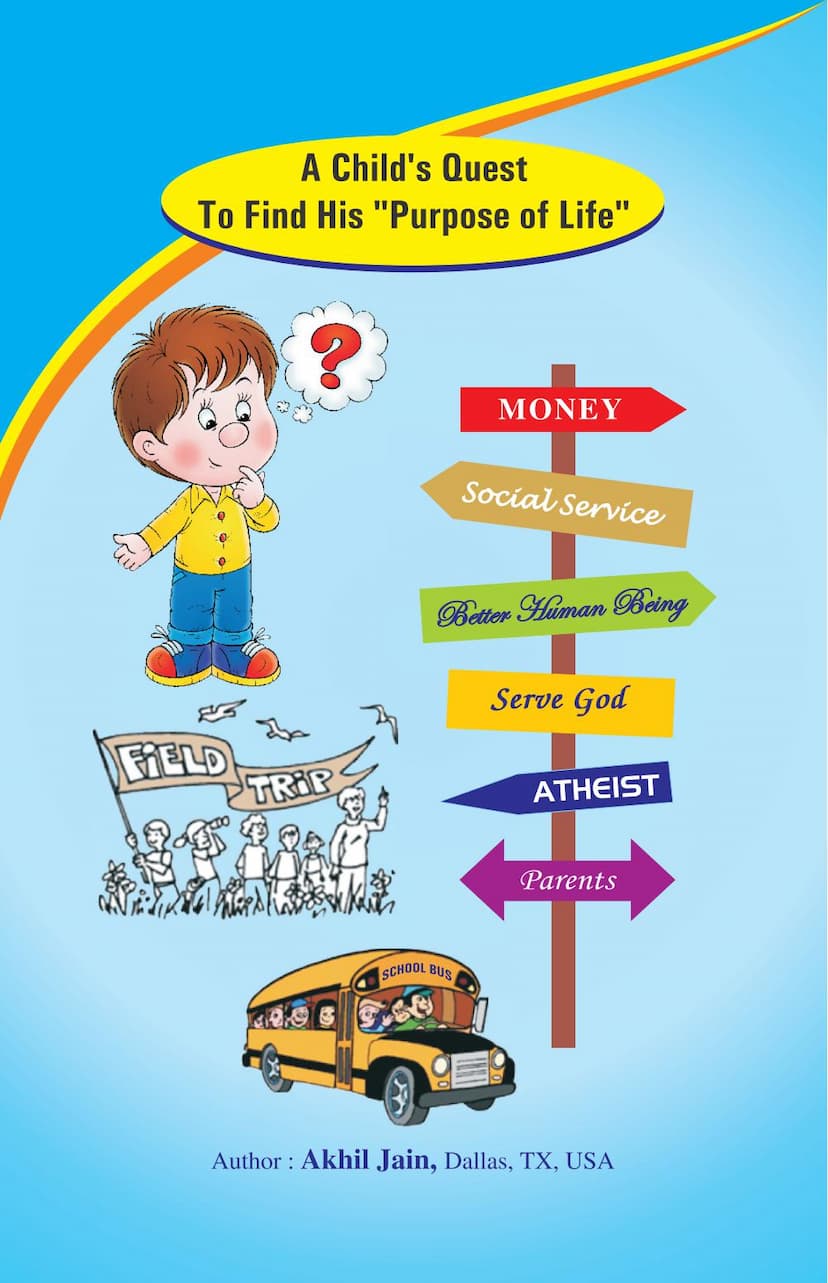Childs Quest To Find His Purpose Of Life
Added to library: September 1, 2025

Summary
Here is a comprehensive summary of the Jain text "A Child's Quest to Find His Purpose of Life" by Akhil Jain, based on the provided pages:
Book Title: A Child's Quest to Find His Purpose of Life Author: Akhil Jain Publisher: Akhil Jain Theme: The book explores the fundamental question of the purpose of life through the innocent yet profound curiosity of a child, presenting various paths and ultimately guiding towards Jain principles.
Core Narrative:
The book follows a young boy named Neel who is deeply contemplative about the meaning of life. He questions if life is merely about growing up, working, marrying, raising a family, and eventually dying, similar to animals. He wonders about the role of religion and what it truly offers humans.
Neel's father suggests he ask his Pathshala (Sunday school) teacher. At Pathshala, Neel and his classmates discuss their aspirations and what they believe will make them happy. They realize that while many professions and material possessions are desired, their connection to true happiness is unclear. The teacher, recognizing their confusion, proposes a "field trip" to a unique fair organized to provide answers on life's purpose.
The "Purpose of Life" Fair:
The fair features various "stalls," each representing a different philosophy or life purpose. The children, sticking together as a group, explore these stalls:
-
"Make Lots of Money": This stall, run by corporations, promises happiness through accumulating wealth and material possessions. While many students are initially enticed, one student questions if fulfilling desires truly leads to lasting happiness, citing the examples of Jain spiritual leaders who renounced wealth. Some who sign up realize the temporary nature of material pleasure and the cycle of endless desire.
-
"Make the World a Better Place": Represented by charitable organizations, environmentalists, and politicians, this stall promotes dedicating life to social service and helping others. While noble, the students ponder what happens when circumstances prevent them from helping or if their actions are misunderstood. They question if relying on external validation or fulfilling the desires of others leads to true peace.
-
"Be a Better Person Within Yourself": This stall, aligned with principles of righteousness and good conduct, emphasizes controlling one's feelings, emotions, and performing good deeds to attract "good karma." However, the students question the ability to control emotions and the potential for self-judgment and disappointment if negative feelings arise. They recognize the good intent but also the practical challenges and the possibility of internal conflict.
-
"Dedicate Yourself to Service of God": Run by religious figures, this stall promotes devotion, prayer, and temple visits as the path to heaven and worldly pleasures. The students question why God needs service, the concept of a rewarding God when true happiness is described as detachment, and the competitive nature of being God's "best disciple." They also consider the hereditary aspect of religious practice and whether it guarantees happiness.
-
"Atheists" (You Control Everything - Not God): Represented by successful secular figures, this stall emphasizes self-determination, hard work, and the absence of divine intervention. The students question the explanation for life's randomness and the potential for goals to remain unfulfilled due to external factors. They recognize the "dangling carrot" analogy, where continuous striving without ultimate contentment leads to a never-ending pursuit.
-
"Parents": This stall advocates for following the paths chosen by parents and society, which often mirror the principles presented in the previous stalls (money, societal contribution, personal conduct, and religious service). The students, particularly Neel, question the wisdom of blindly following and whether these commonly pursued paths truly lead to happiness or contentment. They highlight the continuous cycle of desire and the pursuit of external validation.
The Revelation and the Path Forward:
After visiting all the stalls and finding them wanting in providing a definitive answer to true happiness, the students seek guidance from their teacher. The teacher explains that the term "stall" implies a place where one stops looking. She reveals that Jinvani (the teachings of the Teerthankars, particularly Bhagwan Mahavir) is the true source of answers.
The core teachings highlighted are:
- Happiness is internal: True happiness is not found in external possessions, achievements, or the fulfillment of desires. It originates from within oneself.
- The Self is Constant: The ultimate goal is to "know yourself and keep knowing yourself" – to discover your true, unchanging self, which is unaffected by external circumstances, karma, or even your own body and feelings.
- Desire leads to Unrest: All desires, whether for good or bad, create a state of wanting and lead to anxiety and stress. True happiness lies in "not having desires" (Veetraagta).
- Jinvani is the Guide: The teachings of the Teerthankars, found in the Shastras and lectures, provide the path to move from "wanting to fulfill desires" to "not having desires."
Neel's Return Home:
Neel returns home with a profound understanding. He explains to his parents that the purpose of life is happiness, which is achieved through Veetraagta (freedom from desires). He clarifies the difference between "needs" (essential for well-being and the pursuit of self-knowledge) and "desires" (optional wants that lead to unrest).
He re-evaluates his father's work, questioning the purpose of accumulating wealth if true happiness lies elsewhere. He understands the necessity of earning for basic needs but emphasizes a responsible approach, avoiding jobs that involve dishonesty or harm. He embraces Ahinsa (non-violence) in his food choices and lifestyle, seeking "Ahinsak Alternatives" and "Jain Food."
Conclusion:
The book concludes with Neel understanding that the real quest is the internal journey of self-discovery, guided by Jain principles. His parents are proud of his newfound clarity and purpose. The narrative emphasizes that while the world presents many external paths, true and lasting happiness is an internal state achieved through understanding oneself and transcending desires, as taught by the Teerthankars.